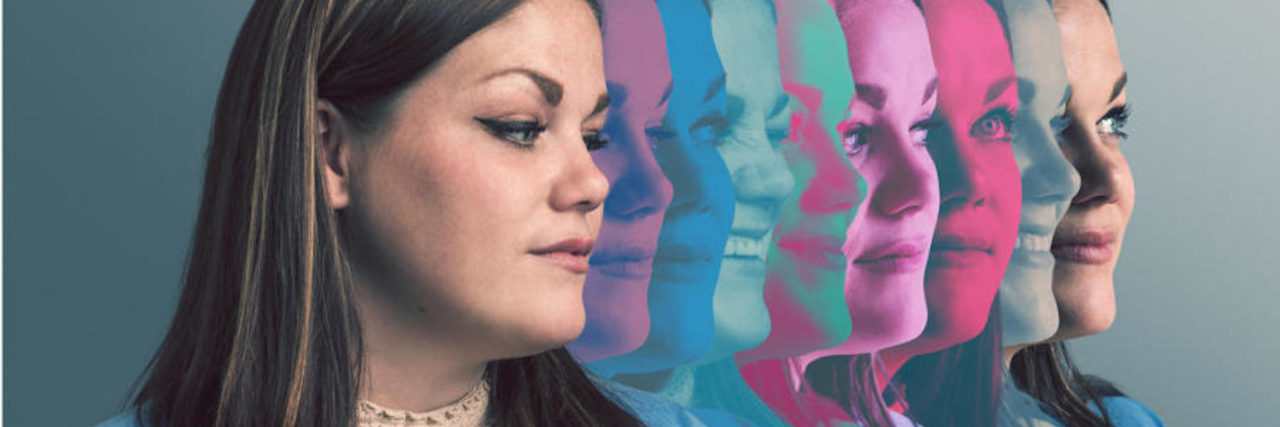New A&E Docuseries 'Many Faces of Jane' Aims to Reduce the Stigma of Dissociative Identity Disorder
Editor's Note
If you’ve experienced sexual abuse or assault, the following post could be potentially triggering. You can contact The National Sexual Assault Telephone Hotline at 1-800-656-4673.
On Tuesday, A&E will air a new docuseries chronicling part of Jane Hart’s journey living with dissociative identity disorder — better known by its old name, multiple personality disorder. In the series, titled “Many Sides of Jane,” Hart hopes “to erase the misconceptions about this highly stigmatized” condition.
In the six-part series, filmmakers follow Hart — a single mother of two boys –both inside and outside of therapy. (If you live with DID, this series may be triggering to you and your parts.) You’ll meet Hart’s nine alternate identities also known as “alters” or “parts,” who range in age from 6 to 28 years old and have various functions within Hart’s “system.” We’ll also see Hart grapple with her DID diagnosis, face her history of childhood abuse and learn more about her parts as they learn to work together.
“It’s validating to finally know I have a reason for the way I am. But it’s also really scary to know I have it, to know that my personality has been fragmented,” Hart told People. “DID literally protected me and saved my life. It’s the mind’s way of preserving the psyche. But it’s also a life sentence.”
Dissociative identity disorder (DID) is a mental health condition that develops as a coping mechanism for surviving severe childhood abuse. Because childhood trauma is so devastating, sometimes the brain dissociates or “splits off” memories of trauma into fragmented parts or alters. This helps you survive because the painful abuse memories are “sealed off” so you can still keep moving forward in your life. Alters typically have varying degrees of their own distinct characteristics, including different names, ages and mannerisms.
If you have DID, you may or may not be aware of all your parts and what they’re up to. Some people with DID “lose time” while another alter is out and doing things, which could be helpful like going to work or cooking, or less helpful, like going on an unexpected shopping spree. Other common experiences of DID include large and small gaps in memory about anything from personal information to what you have been doing for the last several hours.
Many people can function without a true understanding of their DID experience for years before they are ready to face their dissociated abuse memories and get a diagnosis from a qualified therapist. Hart will share a similar experience in the documentary.
“My whole childhood I knew I was afraid—I just didn’t know of what,” Hart told People. “I didn’t know the true breadth of the abuse until after my parts began telling their stories.”
DID affects about 1 percent of the U.S. population, the same rate as schizophrenia. While many portrayals of DID in movies and TV shows like “The United States of Tara” show DID as a dramatic condition with obvious, flamboyant personality shifts, the reality of DID is usually more subtle. According to the International Society for the Study of Trauma and Dissociation, only 6 percent of those with DID will outwardly show obvious switches between alters.
Hart became the subject of this A&E docuseries following a 2016 article she wrote about what it’s like to live with DID. DID, as Hart highlighted in her article, is one of the most stigmatized and misunderstood mental health conditions. There are world-renowned mental health professionals who call the disorder a “hoax” and Hollywood movies — such as the recent box office hit “Glass” — that portray people who live with DID as sensational and violent.
Tune in this Tuesday, January 22 @ 10pm ET on @AETV to watch my new documentary series, Many Sides of Jane. We have soooo much to teach the world about this highly stigmatized disorder and the human brain’s response to traumatic events. #ManySidesofJane #shatterstigma https://t.co/qNx6ThVbhm
— Jane Hart (@realJaneHart) January 20, 2019
Hart hopes the docuseries, which airs Tuesdays at 10 p.m. on A&E, and her story will start to change the negative perception of DID and the resulting misunderstanding.
“It’s nothing like Hollywood portrays it. When people look at someone with DID they immediately think, ‘That person has someone inside who wants to kill people.’ But that’s just not how it works,” Hart said. “The stigma is really thick, but I think it’s time we right that wrong.”
Header image via A&E’s Facebook page.

